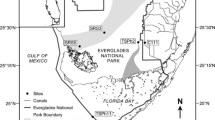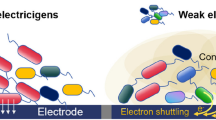Abstract
We studied potential methane (CH4) production and Fe (III) oxide reduction activity in sediments sampled from 12 vegetated littoral sites at eight lakes in Finland. The effects of added amorphous Fe (III) oxyhydroxide and organic substrate (acetate) on methanogenic and Fe (III) reduction activities were studied in anaerobic laboratory incubations (in vitro). The concentration of total iron in the sediments varied between 0.3 and 7.7 % (DW) and their organic matter content (loss of ignition) varied between 1 and 64 % (DW). The potential methane production at vegetated littoral sites varied greatly and was between 0.4 and 312 μmol CH4 kg−1d−1. Fe (III) addition suppressed methane production by over 50 % if the total iron content in the studied littoral sediment was ≥3 % (DW). Our results show that Fe (III) reduction is an important factor for organic matter decomposition in boreal freshwater littoral sediments. In addition to affecting methanogenesis, iron may also play a role in suppressing other microbial activities in anaerobic soils and sediments.



Similar content being viewed by others
References
Achtnich C (1995) Competition for electron-donors among nitrate reducers, ferric iron reducers, sulfate reducers, and methanogens in anoxic paddy soil. Biology and Fertility of Soils 19:65–72
Beal EJ, House CH, Orphan VJ (2009) Manganese- and iron-dependent marine methane oxidation. Science 325:184–187
Blazewicz SJ, Petersen DG, Waldrop MP, Firestone MK (2012) Anaerobic oxidation of methane in tropical and boreal soils: ecological significance in terrestrial methane cycling. Journal of Geophysical Research Biogeosciences. doi:10.1029/2011JG001864
Bond DR, Lovley DR (2002) Reduction of Fe (III) oxide by methanogens in the presence and absence of extracellular quinones. Environmental Microbiology 4:115–124
Boudot JP, Bel Hadj BA, Steiman R, Seigle-Murandi F (1989) Biodegeneration of synthetic organo-metallic complexes of iron and aluminum with selected metal to carbon ratios. Biology & Biochemistry 21:961–966
Capone DG, Kiene RP (1988) Comparison of microbial dynamics in marine and fresh-water sediments - contrasts in anaerobic carbon catabolism. Limnology and Oceanography 33:725–749
Claypool GE, Kaplan IR (1974) The origin and distribution of methane in marine sediments. In: Kaplan IR (ed) Natural gases in marine sediments. Plenum, pp 99–139
Conrad R (1989) Control of methane production in terrestrial ecosystems. In: Andreae MO, Schimel DS (eds) Exchange of trace gases between terrestrial ecosystems and the atmosphere. Dahlem Konferenzen Wiley, Chichester, pp 39–58
Conrad R (1999) Contribution of hydrogen to methane production and control of hydrogen concentrations in methanogenic soils and sediments. FEMS Microbiology Ecology 28:193–202
Deppenmeier U, Müller V, Gottschalk G (1996) Pathways of energy conservation in methanogenic archaea. Archives of Microbiology 165:149–163
Fenchel T, Blackburn TH (1979) Bacteria and mineral cycling. Academic
Frenzel P, Bosse U, Janssen PH (1999) Rice roots and methanogenesis in a paddy soil: ferric iron as an alternative electron acceptor in the rooted soil. Soil Biology and Biochemistry 31:421–430
Fung I, John J, Lerner J, Matthews E, Prather M, Steele MP, Fraser PJ (1991) Three dimensional model synthesis of the global methane cycle. Journal of Geophysical Research 96:13033–13065
Gorham E (1991) Northern Peatlands: role in the carbon cycles and probable responses to climatic warming. Ecological Applications 1:182–195
Hyvönen T, Ojala A, Kankaala P, Martikainen PJ (1998) Methane release from stands of water horsetail (Equisetum fluviatile) in boreal lake. Freshwater Biology 40:275–284
Jacobson ME (1994) Chemical and biological mobilization of Fe (III) in marsh sediments. Biogeochemistry 25:41–60
Jones DL, Edwards AC (1998) Influence of sorption on the biological utilization of two simple carbon substrates. Soil Biology and Biochemistry 30:1895–1902
Jones AM, Pham AN, Collins RN, Waite TD (2009) Dissociation kinetics of Fe (III)- and Al (III)- natural organic matter complexes at pH 6.0 and 8.0 and 25 °C. Geochimica et Cosmochimica Acta 73:2875–2887
Juutinen S, Alm J, Larmola T, Huttunen JT, Morero M, Martikainen PJ, Silvola J (2003) Major implication of the littoral zone for methane release from boreal lakes. Global Biogeochemical Cycles 17:1117–1128. doi:10.1029/2003GB002105
Kankaala P, Käki T, Ojala A (2003) Quality of detritus impacts on spatial variation of methane emissions from littoral sediment of a boreal lake. Archives of Hydrobiology 157:47–66
Kankaala P, Käki T, Mäkelä S, Ojala A, Pajunen H, Arvola L (2005) Methane efflux in relation to plant biomass and sediment characteristics in stands of three common emergent macrophytes in boreal mesoeutrophic lakes. Global Change Biology 11:145–153
King GM (1996) In situ analyses of methane oxidation associated with the roots and rhizomes of a bur reed, Sparganium eurycarpum, in a maine wetland. Applied and Environmental Microbiology 62:4548–4555
Kostka JE, Luther GW (1995) Seasonal cycling of Fe in salt-marsh sediments. Biogeochemistry 29:159–181
Laanbroek HL (1990) Bacterial cycling of minerals that affect plant growth in waterlogged soils: a review. Aquatic Botany 38:109–125
Lalonde K, Mucci A, Ouellet A, Gelinas Y (2012) Preservation of organic matter in sediments promoted by iron. Nature 483:198–200
Liu D, Dong H, Bishop ME, Wang H, Agrawal A, Tritschler S, Eberl DD, Xie S (2011) Reduction of structural Fe (III) in nontronite by methanogen Methanosarcina barkeri. Geochim Cosmochim Acta 6994–7010
Lovley DR (1987) Organic matter mineralization with the reduction of ferric iron: a review. Geomicrobiology Journal 5:375–399
Lovley DR (1991) Dissimilatory Fe (III) and Mn (IV) reduction. Microbiological Reviews 55:259–287
Lovley DR, Phillips EJP (1986a) Availability of ferric iron for microbial reduction in bottom sediments of the fresh water tidal Potomac River. Applied and Environmental Microbiology 52:751–757
Lovley DR, Phillips EJP (1986b) Organic matter mineralization with reduction of ferric iron in anaerobic sediments. Applied and Environmental Microbiology 51:683–689
Lovley DR, Phillips EJP, Lonergan DJ (1989) Hydrogen and formate oxidation coupled to dissimilatory reduction of iron or manganese by alteromonas putrefaciens. Applied and Environmental Microbiology 55:700–706
Lovley DR, Coates JD, Blunt-Harris EL, Phillips EJP, Woodward JC (1996a) Humic substances as electron acceptors for microbial respiration. Nature 382:445–448
Lovley DR, Woodward JC, Chapelle FH (1996b) Rapid anaerobic benzene oxidation with a variety of chelated Fe (III) forms. Applied and Environmental Microbiology 62:288–291
Lovley DR, Fraga JL, Blunt-Harris EL, Phillips EJP, Coates JD (1998) Humic substances as a mediator for microbially catalyzed metal reduction. Acta Hydrochimica et Hydrobiologica 26:152–157
Luther GW, Kostka JE, Church TM, Sulzberger B, Stumm W (1992) Seasonal iron cycling in the salt-marsh sedimentary environment – the importance of ligand complexes with Fe (II) and Fe (III) in the dissolution of Fe (III) minerals and pyrite, respectively. Marine Chemistry 40:81–103
Mechalas BJ (1974) Pathways and environmental requirements for biogenic gas production in the ocean. In: Kaplan IR (ed) Natural gases in marine sediments. Plenum, pp 11–25
Mendelssohn IA, Kleiss BA, Wakeley JS (1995) Factors controlling the formation of oxidized root channels – a review. Wetlands 15:37–46
Neue HU, Roger PA (1993) Rice agriculture: factors controlling emissions. In: Khalil MAK (ed) Atmospheric methane: sources. Sinks and Role in Global Change. Springer, Berlin, Germany, pp 254–298
Nierop KGJ, Jansen B, Verstraten JM (2002) Dissolved organic matter, aluminium and iron interactions: precipitation induced by metal / carbon ratio, pH and competition. The Science of the Total Environment 300:201–211
Norđi K, Thamdrup B, Schubert CJ (2013) Anaerobic oxidation of methane in an iron-rich Danish freshwater lake sediment. Limnology and Oceanography 58:546–554
Nykänen H, Alm J, Silvola J, Tolonen K, Martikainen PJ (1998) Methane fluxes on boreal peatlands of different fertility and the effect of long-term experimental lowering of the water table on flux rates. Global Biogeochemical Cycles 12:53–69
Prather M, Derwent R, Ehhalt D, Fraser P, Sanhueaza E, Zhou X (1995) Other trace gases and atmospheric chemistry. In: Houghton JT et al. (ed) Climate changes 1994. Radiative forcing of climate change and an evaluation of the IPCC IS92 emissions scenarios. Cambridge University Press, pp 73–126
Reiche M, Torburg G, Küsel K (2008) Competition of Fe (III) reduction and methanogenesis in an acidic fen. Microbial Ecology 65:88–101
Roden EE (2008) Microbiological controls on geochemical kinetics 1: fundamentals and case study on microbial Fe (III) oxide reduction. Kinetics of Water-Rock Interaction. Springer, New York, In, pp 335–415
Roden EE, Wetzel RG (1996) Organic carbon oxidation and suppression of methane production by microbial Fe (III) oxide reduction in vegetated and unvegetated freshwater wetland sediments. Limnology and Oceanography 4:1733–1748
Rose J, Vilge A, Olivie-Lauquet G, Maison A, Frechou C, Bottero JY (1998) Iron speciation in natural organic matter colloids. Colloids and Surfaces A-Physicochemical and Engineering Aspects 136:11–19
Saarnio S, Morero M, Shurpali N, Tuittila E-S, Mäkilä M, Alm J (2007) Annual CO2 and CH4 fluxes of pristine boreal mires as a background for the lifecycle analyses of peat energy. Boreal Environment Research 12:101–113
Saarnio S, Winiwarter W, Leitäo J (2009) Methane release from wetlands and watercourses in Europe. Atmospheric Environment 43:1421–1429
Schink B (1997) Energetics of syntrophic cooperation in methanogenic degradation. Microbiology and Molecular Bioliogy Reviews R 61:262–280
Schulz S, Matsuyams H, Conrad R (1997) Temperature dependence of methane production from different precursors in a profundal sediment (Lake Constance). FEMS Microbiology Ecology 20:1–14
Sørensen J (1982) Reduction of ferric iron in anaerobic, marine sediments and interaction with reduction of nitrate and sulfate. Applied and Environmental Microbiology 43:319–324
Stams AJM (1994) Metabolic interactions between anaerobic bacteria in methanogenic environments. Antonie van Leeuwenhoek International Journal of General and Molecular Microbiology 66:271–294
Stocker TF, Qin D, Plattner GK et al (2013) IPCC summary for policymakers. In: climate change 2013: the physical science basis. contribution of working group i to the fifth assessment report of the intergovernmental panel on climate change. Cambridge University Press, Cambridge and New York
Thauer RK, Jungerman K, Decker K (1977) Energy conservation in chemotrophic anaerobic bacteria. Bacteriological Reviews 44:100–180
Vargas M, Kashefi K, Blunt-Harris EL, Lovley DR (1998) Microbiological evidence for Fe (III) reduction on early earth. Nature 39:65–67
Weber T, Allard T, Tipping E, Benedetti MF (2006) Modeling iron binding to organic matter. Environmental Science and Technology 40:7488–7493. doi:10.1021/es0607077
Weiss JV, Emerson D, Megonigal JP (2005) Rhizospher iron (III) deposition and reduction in a Juncus effuses L.-dominated wetland. Soil Science Society of America Journal 69:1861–1870
Westermann P (1993) Wetland and swamp microbiology. In: Ford TE (ed) Aquatic microbiology: an ecological approach. Blackwell, London, pp 295–302
Zehnder AJB (1978) Ecology of methane formation. In: Mitchell R (ed) Water pollution microbiology. Wiley, New York, pp 349–376
Zehnder AJB, Stumm W (1988) Geochemistry and biogeochemistry of anaerobic habitats. In: Zehnder AJB (ed) Biology of anaerobic microorganisms. Wiley, New York, pp 1–38
Zhang J, Dong H, Liu D, Fischer TB, Wang S, Huang L (2012) Microbial reduction of Fe (III) in illite-smectite minerals by methanogen Methanosarcina mazei. Chemical Geology 292:35–44
Acknowledgments
This research was supported financially by the Maj and Tor Nessling foundation. We wish to thank Kari Ratilainen (Department of Biology, University of Eastern Finland) and Jussi Vilen (Lammi Biological Station, University of Helsinki) for their help with collecting sediment and peat samples, and Sanna Saarnio (University of Eastern Finland, Joensuu) for her helpful suggestions on the manuscript. We are grateful to two anonymous reviewers for their suggestions improving the manuscript.
Author information
Authors and Affiliations
Corresponding author
Electronic supplementary material
Below is the link to the electronic supplementary material.
ESM 1
(PDF 161 kb)
Rights and permissions
About this article
Cite this article
Karvinen, A., Lehtinen, L. & Kankaala, P. Variable Effects of Iron (Fe (III)) Additions on Potential Methane Production in Boreal Lake Littoral Sediments. Wetlands 35, 137–146 (2015). https://doi.org/10.1007/s13157-014-0602-6
Received:
Accepted:
Published:
Issue Date:
DOI: https://doi.org/10.1007/s13157-014-0602-6




